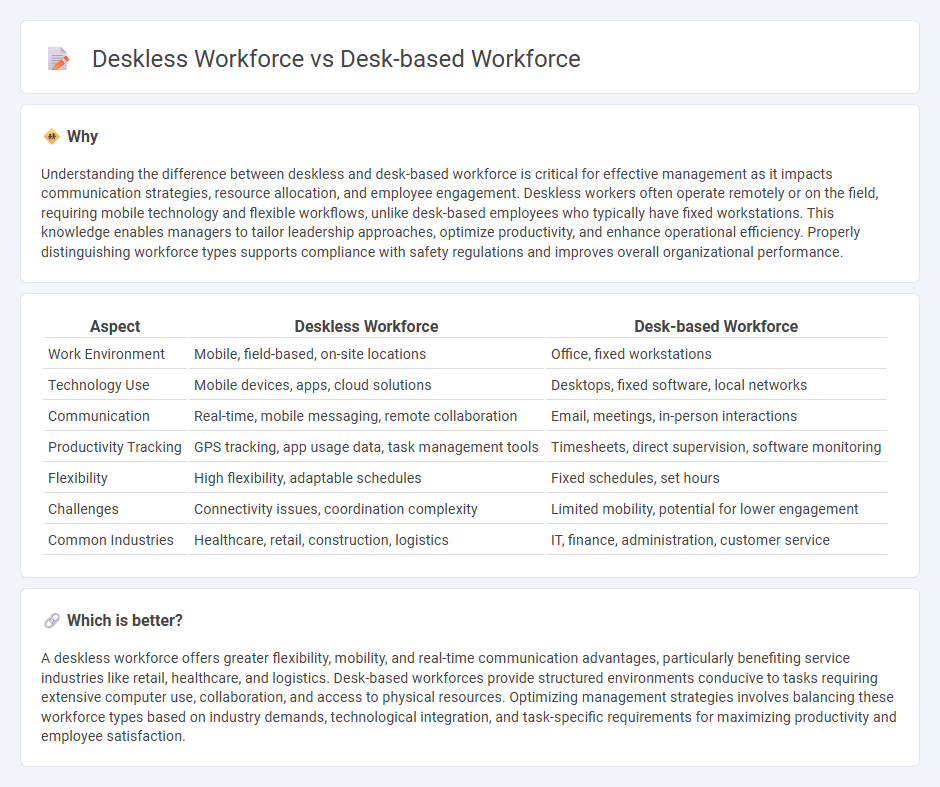
The management of deskless workforce focuses on mobile, frontline employees engaged in hands-on tasks, requiring real-time communication tools and flexible scheduling to enhance productivity. In contrast, desk-based workforce management centers around office-bound staff with structured environments, relying on traditional oversight, performance metrics, and digital collaboration platforms. Explore effective strategies for managing both workforce types to optimize business outcomes.
Why it is important
Understanding the difference between deskless and desk-based workforce is critical for effective management as it impacts communication strategies, resource allocation, and employee engagement. Deskless workers often operate remotely or on the field, requiring mobile technology and flexible workflows, unlike desk-based employees who typically have fixed workstations. This knowledge enables managers to tailor leadership approaches, optimize productivity, and enhance operational efficiency. Properly distinguishing workforce types supports compliance with safety regulations and improves overall organizational performance.
Comparison Table
| Aspect | Deskless Workforce | Desk-based Workforce |
|---|---|---|
| Work Environment | Mobile, field-based, on-site locations | Office, fixed workstations |
| Technology Use | Mobile devices, apps, cloud solutions | Desktops, fixed software, local networks |
| Communication | Real-time, mobile messaging, remote collaboration | Email, meetings, in-person interactions |
| Productivity Tracking | GPS tracking, app usage data, task management tools | Timesheets, direct supervision, software monitoring |
| Flexibility | High flexibility, adaptable schedules | Fixed schedules, set hours |
| Challenges | Connectivity issues, coordination complexity | Limited mobility, potential for lower engagement |
| Common Industries | Healthcare, retail, construction, logistics | IT, finance, administration, customer service |
Which is better?
A deskless workforce offers greater flexibility, mobility, and real-time communication advantages, particularly benefiting service industries like retail, healthcare, and logistics. Desk-based workforces provide structured environments conducive to tasks requiring extensive computer use, collaboration, and access to physical resources. Optimizing management strategies involves balancing these workforce types based on industry demands, technological integration, and task-specific requirements for maximizing productivity and employee satisfaction.
Connection
The deskless workforce relies heavily on mobile technology and cloud-based platforms to stay connected with desk-based employees, enabling real-time communication and collaboration. Management systems integrate data from both workforces to streamline operations, enhance productivity, and ensure seamless workflow across different environments. Effective leadership bridges the gap by adopting flexible communication strategies that address the distinct needs of deskless and desk-based workers.
Key Terms
Remote Work
The desk-based workforce primarily operates from stationary office desks, leveraging fixed technology and infrastructure, while the deskless workforce engages in mobile, location-independent roles often requiring portable devices and real-time communication tools. Remote work has accelerated the shift toward deskless environments, enabling employees in industries like healthcare, retail, and logistics to remain productive outside traditional offices through cloud-based platforms and collaboration apps. Discover key strategies and tools to optimize productivity in both desk-based and deskless remote work settings.
Mobile Workforce
The deskless workforce, often referred to as the mobile workforce, consists of employees who perform their tasks outside of traditional office environments, relying heavily on mobile technology for real-time communication, task management, and data access. This segment includes professions such as field service technicians, healthcare workers, and delivery drivers, making up about 80% of the global workforce according to Verizon's Mobile Workforce Report 2023. Explore how businesses leverage mobile solutions to enhance productivity and operational efficiency in the evolving landscape of deskless employment.
Workplace Flexibility
Desk-based workforce typically relies on fixed office locations, limiting mobility but enabling structured work environments optimized for productivity and collaboration. Deskless workforce operates remotely or on-site without assigned desks, benefiting from greater workplace flexibility, enhancing real-time responsiveness and employee autonomy. Discover how organizations balance these models to optimize workforce efficiency and satisfaction.
Source and External Links
Desk-Based Roles See Application Surges Amid Slowing Demand - This article discusses how desk-based job sectors are experiencing a surge in competition and application volume, while facing challenges like slowing demand and growing AI adoption.
Desk-Based Roles See Application Surges Amid Slowing Demand - Employ data reveals a growing divide in labor demand between desk-based roles and frontline workers, highlighting challenges in job postings and talent shortages.
Is flexible working expanding the gulf between desk-based and deskless workers? - This article explores how flexible working might widen the gap between desk-based workers, who often enjoy more flexibility, and deskless workers, who face different challenges despite comprising a large portion of the workforce.
 dowidth.com
dowidth.com